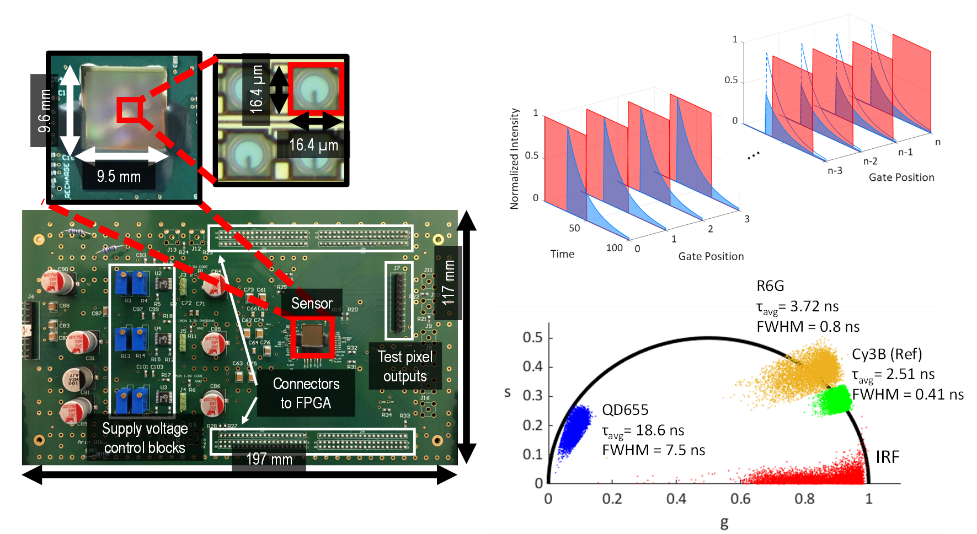Single-photon avalanche diodes (SPADs) are solid-state photodetectors that capture light at single-photon level with high timing resolution. The introduction of SPADs in standard CMOS process technology has enabled these detectors to take advantage of fast readout and parallel data processing ability at high speeds offered by integrated CMOS electronics. Our work in this field is focused on using SPAD cameras for various microscopy applications where high timing resolution, single-photon sensitivity and fast data processing are of key importance.
Fluorescence lifetime imaging microscopy (FLIM) is one of the applications that benefit from these merits of SPAD detectors. Conventional time-domain FLIM methods based on curve fitting are unable to rapidly analyze complex samples. The phasor method was introduced as a faster alternative with its use of simple arithmetic operations to estimate fluorescence lifetime. Because of its ability to visually separate different fluorophores and its compatibility with the quantitative analysis of multi-exponential decays, we chose the phasor method for our widefield FLIM approach.
SwissSPAD2, a 512×512 gated SPAD imager was used for our phasor-based FLIM experiments. Due to the implementation challenges of in-pixel timestamping for large arrays, SwissSPAD2 instead uses long time gates to perform time-resolved imaging. To analyze samples with shorter lifetime range than the gate lengths, we adapted the classical TCSPC-based phasor method to time-gated cameras. Using this approach, it is possible to visually distinguish fluorescent dyes with nanoseconds of lifetime difference on the graphical phasor plot at video-rate speeds and sub-ns precision. This method is also compatible with the quantitative analysis of complex samples with multi-exponential fluorescent decays. Using simple arithmetic operations, it is possible to rapidly extract the volume ratios of fluorescent mixtures, which is an essential step for Förster resonance energy transfer (FRET) analysis, a tool to observe molecular interactions and conformational changes in live cells.
The future objective of our FLIM work is to perform lifetime estimation of complex samples at video-rate speeds. To achieve that, we are currently working on FPGA and ASIC-based implementation of parallel data processing of the gated phasor method. Ongoing works also include photon sensitivity improvement of the cameras using microlenses and the optimization of the phasor method for better photon economy, i.e. the achievement of higher lifetime estimation precision with fewer number of photons. With these performance improvements, we ultimately aim to make our method compatible with the target applications such as cancer detection and targeted drug delivery monitoring.

Figure 1 – Left: SwissSPAD2 camera module. Top Right: Conceptual illustration of time-gated FLIM. Bottom Right: Phasor plots of quantum dots (QD655), Rhodamine 6G (R6G) solution and Cy3B solution. Mean and FWHM of the extracted lifetimes are annotated.
Relevant publications
- A. Ulku, A. Ardelean, M. Antolovic, S. Weiss, E. Charbon, C. Bruschini, and X. Michalet, “Wide-field time-gated SPAD imager for phasor-based FLIM application,” in bioRxiv, Art. no. 687277, 2019.
- A.C. Ulku, C. Bruschini, I.M. Antolovic, Y. Kuo, R. Ankri, S. Weiss, X. Michalet, and E. Charbon, “A 512×512 SPAD image sensor with integrated gating for widefield FLIM,” in IEEE J. Sel. Top. Quantum Electron., vol. 25, no. 1, pp. 1-12, Jan-Feb 2019, Art. no. 6801212.
- A.C. Ulku, C. Bruschini, I.M. Antolovic, S. Weiss, X. Michalet, and E. Charbon, “Phasor-based widefield FLIM using a gated 512×512 single-photon SPAD imager,” in Proc. SPIE, San Francisco, CA, USA, 2019, Paper 108820M.
- A. Ardelean, A.C. Ulku, X. Michalet, E. Charbon, and C. Bruschini, “Fluorescence lifetime imaging with a single-photon SPAD array using long overlapping gates: an experimental and theoretical study,” in Proc. SPIE, San Francisco, CA, USA, 2019, Paper 108820Y.
- I.M. Antolovic, A.C. Ulku, E. Kizilkan, S. Lindner, F. Zanella, R. Ferrini, M. Schnieper, E. Charbon, and C. Bruschini, “Optical-stack optimization for improved SPAD photon detection efficiency,” in Proc. SPIE, San Francisco, CA, USA, 2019, Poster 109262T.
- A.C. Ulku, C. Bruschini, S. Weiss, X. Michalet, and E. Charbon, “A time-gated large-array SPAD camera for picosecond resolution real-time FLIM,” in SPIE Photonics West, San Francisco, CA, USA, 2018, Conference presentation 104980M.
- A.C. Ulku, C. Bruschini, X. Michalet, S. Weiss, and E. Charbon, “A 512×512 SPAD image sensor with built-in gating for phasor based real-time siFLIM,” in IISW, Hiroshima, Japan, 2017.
- R. Ankri, A. Basu, A.C. Ulku, C. Bruschini, E. Charbon, S. Weiss, and X. Michalet, “Single photon, time-gated, phasor-based fluorescence lifetime imaging through highly scattering medium,” in bioRxiv, Art. no. 686998, 2019.
Collaboration
University of California, Los Angeles (UCLA)